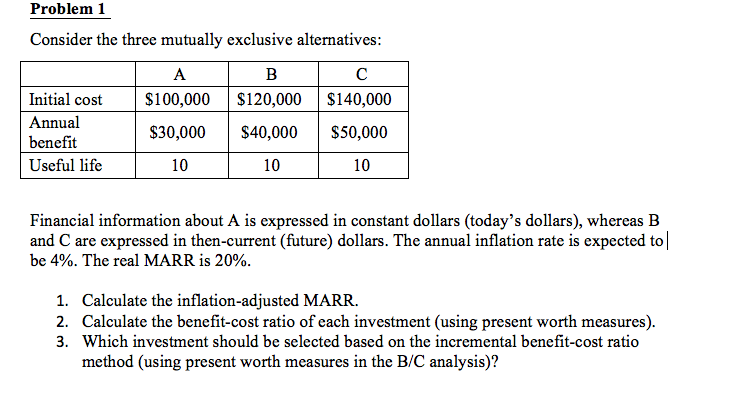Consider the three mutually exclusive alternatives: A B Initial cost $100,000 $120,000 $140,000 Annual $30,000 $40,000 $50,000 benefit Useful life 10 10 10 Financial information about A is expressed in constant dollars (today's dollars), whercas B and C are expressed in then-current (future) dollars. The annual inflation rate is expected to| be 4%. The real MARR is 20%. 1. Calculate the inflation-adjusted MARR. 2. Calculate the benefit-cost ratio of each investment (using present worth measures). 3. Which investment should be selected based on the incremental benefit-cost ratio method (using present worth measures in the B/C analysis)?
Consider the three mutually exclusive alternatives: A B Initial cost $100,000 $120,000 $140,000 Annual $30,000 $40,000 $50,000 benefit Useful life 10 10 10 Financial information about A is expressed in constant dollars (today's dollars), whercas B and C are expressed in then-current (future) dollars. The annual inflation rate is expected to| be 4%. The real MARR is 20%. 1. Calculate the inflation-adjusted MARR. 2. Calculate the benefit-cost ratio of each investment (using present worth measures). 3. Which investment should be selected based on the incremental benefit-cost ratio method (using present worth measures in the B/C analysis)?
Essentials Of Investments
11th Edition
ISBN:9781260013924
Author:Bodie, Zvi, Kane, Alex, MARCUS, Alan J.
Publisher:Bodie, Zvi, Kane, Alex, MARCUS, Alan J.
Chapter1: Investments: Background And Issues
Section: Chapter Questions
Problem 1PS
Related questions
Question
100%

Transcribed Image Text:Problem 1
Consider the three mutually exclusive alternatives:
A
B
Initial cost
$100,000
$120,000
$140,000
Annual
$30,000
$40,000
$50,000
benefit
Useful life
10
10
10
Financial information about A is expressed in constant dollars (today's dollars), whereas B
and C are expressed in then-current (future) dollars. The annual inflation rate is expected to|
be 4%. The real MARR is 20%.
1. Calculate the inflation-adjusted MARR.
2. Calculate the benefit-cost ratio of each investment (using present worth measures).
3. Which investment should be selected based on the incremental benefit-cost ratio
method (using present worth measures in the B/C analysis)?
Expert Solution
This question has been solved!
Explore an expertly crafted, step-by-step solution for a thorough understanding of key concepts.
Includes step-by-step video
Learn your way
Includes step-by-step video
Step by step
Solved in 2 steps with 3 images

Knowledge Booster
Learn more about
Need a deep-dive on the concept behind this application? Look no further. Learn more about this topic, finance and related others by exploring similar questions and additional content below.Recommended textbooks for you

Essentials Of Investments
Finance
ISBN:
9781260013924
Author:
Bodie, Zvi, Kane, Alex, MARCUS, Alan J.
Publisher:
Mcgraw-hill Education,



Essentials Of Investments
Finance
ISBN:
9781260013924
Author:
Bodie, Zvi, Kane, Alex, MARCUS, Alan J.
Publisher:
Mcgraw-hill Education,



Foundations Of Finance
Finance
ISBN:
9780134897264
Author:
KEOWN, Arthur J., Martin, John D., PETTY, J. William
Publisher:
Pearson,

Fundamentals of Financial Management (MindTap Cou…
Finance
ISBN:
9781337395250
Author:
Eugene F. Brigham, Joel F. Houston
Publisher:
Cengage Learning

Corporate Finance (The Mcgraw-hill/Irwin Series i…
Finance
ISBN:
9780077861759
Author:
Stephen A. Ross Franco Modigliani Professor of Financial Economics Professor, Randolph W Westerfield Robert R. Dockson Deans Chair in Bus. Admin., Jeffrey Jaffe, Bradford D Jordan Professor
Publisher:
McGraw-Hill Education